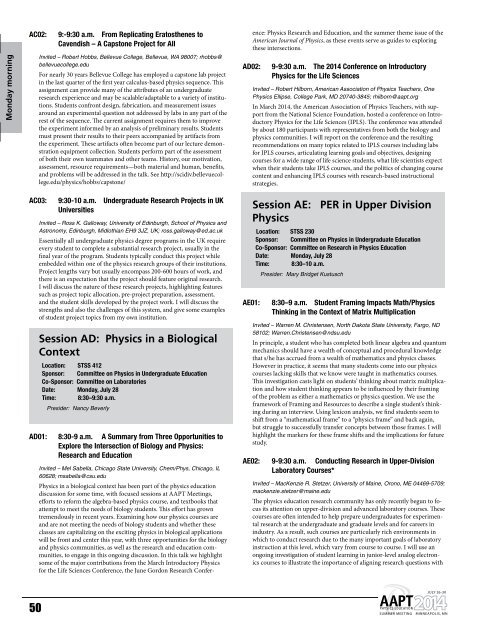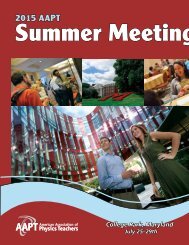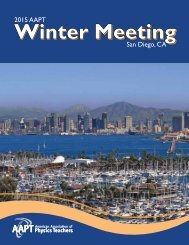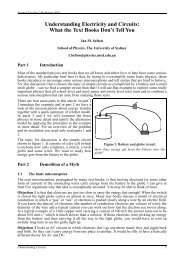Monday morningAC02: 9:-9:30 a.m. From Replicating Eratosthenes toCavendish – A Capstone Project for AllInvited – Robert Hobbs, Bellevue College, Bellevue, WA 98007; rhobbs@bellevuecollege.eduFor nearly 30 years Bellevue College has employed a capstone lab projectin the last quarter of the first year calculus-based physics sequence. Thisassignment can provide many of the attributes of an undergraduateresearch experience and may be scalable/adaptable to a variety of institutions.Students confront design, fabrication, and measurement issuesaround an experimental question not addressed by labs in any part of therest of the sequence. The current assignment requires them to improvethe experiment informed by an analysis of preliminary results. Studentsmust present their results to their peers accompanied by artifacts fromthe experiment. These artifacts often become part of our lecture demonstrationequipment collection. Students perform part of the assessmentof both their own teammates and other teams. History, our motivation,assessment, resource requirements—both material and human, benefits,and problems will be addressed in the talk. See http://scidiv.bellevuecollege.edu/physics/hobbs/capstone/Invited – Mel Sabella, Chicago State University, Chem/Phys, Chicago, IL60628; msabella@csu.eduPhysics in a biological context has been part of the physics educationdiscussion for some time, with focused sessions at AAPT Meetings,efforts to reform the algebra-based physics course, and textbooks thatattempt to meet the needs of biology students. This effort has growntremendously in recent years. Examining how our physics courses areand are not meeting the needs of biology students and whether theseclasses are capitalizing on the exciting physics in biological applicationswill be front and center this year, with three opportunities for the biologyand physics communities, as well as the research and education communities,to engage in this ongoing discussion. In this talk we highlightsome of the major contributions from the March Introductory Physicsfor the Life Sciences Conference, the June Gordon Research Conference:Physics Research and Education, and the summer theme issue of theAmerican Journal of Physics, as these events serve as guides to exploringthese intersections.AD02:9-9:30 a.m. The 2014 Conference on IntroductoryPhysics for the Life SciencesInvited – Robert Hilborn, American Association of Physics Teachers, OnePhysics Ellipse, College Park, MD 20740-3845; rhilborn@aapt.orgIn March 2014, the American Association of Physics Teachers, with supportfrom the National Science Foundation, hosted a conference on IntroductoryPhysics for the Life Sciences (IPLS). The conference was attendedby about 180 participants with representatives from both the biology andphysics communities. I will report on the conference and the resultingrecommendations on many topics related to IPLS courses including labsfor IPLS courses, articulating learning goals and objectives, designingcourses for a wide range of life science students, what life scientists expectwhen their students take IPLS courses, and the politics of changing coursecontent and enhancing IPLS courses with research-based instructionalstrategies.AC03:9:30-10 a.m. Undergraduate Research Projects in UKUniversitiesInvited – Ross K. Galloway, University of Edinburgh, School of Physics andAstronomy, Edinburgh, Midlothian EH9 3JZ, UK; ross.galloway@ed.ac.ukEssentially all undergraduate physics degree programs in the UK requireevery student to complete a substantial research project, usually in thefinal year of the program. Students typically conduct this project whileembedded within one of the physics research groups of their institutions.Project lengths vary but usually encompass 200-600 hours of work, andthere is an expectation that the project should feature original research.I will discuss the nature of these research projects, highlighting featuressuch as project topic allocation, pre-project preparation, assessment,and the student skills developed by the project work. I will discuss thestrengths and also the challenges of this system, and give some examplesof student project topics from my own institution.Session AD: Physics in a BiologicalContextLocation: STSS 412Sponsor: Committee on Physics in Undergraduate EducationCo-Sponsor: Committee on LaboratoriesDate: Monday, July 28Time: 8:30–9:30 a.m.Presider: Nancy BeverlyAD01: 8:30-9 a.m. A Summary from Three Opportunities toExplore the Intersection of Biology and Physics:Research and EducationSession AE: PER in Upper DivisionPhysicsLocation: STSS 230Sponsor: Committee on Physics in Undergraduate EducationCo-Sponsor: Committee on Research in Physics EducationDate: Monday, July 28Time: 8:30–10 a.m.Presider: Mary Bridget KustuschAE01: 8:30–9 a.m. Student Framing Impacts Math/PhysicsThinking in the Context of Matrix MultiplicationInvited – Warren M. Christensen, North Dakota State University, Fargo, ND58102; Warren.Christensen@ndsu.eduIn principle, a student who has completed both linear algebra and quantummechanics should have a wealth of conceptual and procedural knowledgethat s/he has accrued from a wealth of mathematics and physics classes.However in practice, it seems that many students come into our physicscourses lacking skills that we know were taught in mathematics courses.This investigation casts light on students’ thinking about matrix multiplicationand how student thinking appears to be influenced by their framingof the problem as either a mathematics or physics question. We use theframework of Framing and Resources to describe a single student’s thinkingduring an interview. Using lexicon analysis, we find students seem toshift from a “mathematical frame” to a “physics frame” and back again,but struggle to successfully transfer concepts between those frames. I willhighlight the markers for these frame shifts and the implications for futurestudy.AE02: 9-9:30 a.m. Conducting Research in Upper-DivisionLaboratory Courses*Invited – MacKenzie R. Stetzer, University of Maine, Orono, ME 04469-5709;mackenzie.stetzer@maine.eduThe physics education research community has only recently begun to focusits attention on upper-division and advanced laboratory courses. Thesecourses are often intended to help prepare undergraduates for experimentalresearch at the undergraduate and graduate levels and for careers inindustry. As a result, such courses are particularly rich environments inwhich to conduct research due to the many important goals of laboratoryinstruction at this level, which vary from course to course. I will use anongoing investigation of student learning in junior-level analog electronicscourses to illustrate the importance of aligning research questions with50
course learning goals and to highlight some of the challenges associatedwith conducting research in these types of courses.*The work described has been supported in part by the National Science Foundationunder Grant Nos. DUE-1323426, DUE-1022449, and DUE-0962805.AE03: 9:30-10 a.m. Professional Development of Pre-servicePhysicists: Affordances and ConstraintsInvited – Eleanor C. Sayre, Kansas State University, Manhattan, KS 66506;esayre@gmail.comPaul W. Irving, Michigan State UniversityResearch on upper-division students opens up exciting avenues intoprofessional development for pre-service scientists. They learn so muchmore than book content: physics culture, research experiences, benchskills. Their participation is much more meaningful than mere classwork:they try on different identities, aspire to future physics selves, take onorganizational responsibilities. Yet, research on upper-division students isnot all sunshine and roses. In this talk, I discuss some of the affordancesand constraints of research on upper-division students from the lenses of afew projects on their development as pre-service physicists. I may discusshow students build communities of practice in advanced laboratory, howstudents grow to view physics as a prospective professional field, and howwe (as researchers) can tell.Session AF: Teacher Training andEnhancementLocation: Tate Lab 131Sponsor: AAPTDate: Monday, July 28Time: 8:30–9:40 a.m.Presider: Brian PyperContent knowledge for teaching (CKT) is a practice-based theory of theprofessional knowledge that a person needs to be able to carry out tasksof teaching in the classroom (Ball, Thames and Phelps, 2008). SpecificallyCKT addresses what teachers do (these activities are called tasks of teaching)and how their actions take into account students’ prior knowledge andlearning trajectories. One such task of teaching is dealing with unexpectedideas that students bring to the conversation and, therefore, unplannedmoments in the classroom. In this talk, we will present two instances ofteachers facing such unexpected moments in the classroom. We will thendiscuss how elements of Content Knowledge for Teaching and differencesin teachers’ CKT can be inferred from these moments through acombination of video analysis and analysis of the teacher’s reflection on themoment.AF02:8:40-8:50 a.m. Preparing Irish Secondary ScienceTeachers for Inquiry-based Science EducationContributed – Paul Grimes, Dublin City University, Glasnevin, Dublin, Ireland;paul.grimes3@mail.dcu.ieScott McDonald, Pennsylvania State UniversityLeanne Doughty, Paul van Kampen, Dublin City UniversityWe have investigated Irish science teacher candidates’ (TCs’) views of inquiry-basedscience teaching (IBSE) through the lens of their experiencesas science students. This study makes an inventory of the TCs’ conceptionsof IBSE. We describe a course designed to initiate re-enculturation to moreappropriate ways of understanding IBSE: the teacher candidates engage inand critique a variety of inquiry-based activities. We report on the currentculture of science teaching within the Irish school system and contrast itwith the aims set out at policy level. We gain insight into the teacher candidates’ideas about IBSE and their cultural resistance to it. Specifically, weinvestigate what practices the TCs highlight as constituting IBSE and howthey code the purpose of these practices. We describe how these practicesand coded purposes reflect aspects of their professional pedagogical visionof IBSE.Monday morningAF01: 8:30-8:40 a.m. Content Knowledge for Teaching Energy:Addressing Unexpected MomentsContributed – Robert C. Zisk, Rutgers University, New Brunswick, NJ 08901-1281; robert.zisk@gse.rutgers.eduEugenia Etkina, Rutgers UniversityDrew GitomerINTHEEXHIBITHALLAF03:8:50-9 a.m. Physics and Everyday Thinking at WesternWashington UniversityContributed – Andrew Boudreaux, Western Washington University, Bellingham,WA 98225-9164; andrew.boudreaux@wwu.eduAt Western Washington University, historically a teacher training college,pre-service elementary teachers take science content and methods coursesin a multi-disciplinary Science, Math, and Technology Education programKindle/ iPad Drawing mini /Gift Card DrawingsMonday, July 2810:15 a.m. and 3:45 p.m.Tuesday, July 2910:15 a.m. and 3:15 p.m.(Must be present to win)Purchase tickets inadvance at RegistrationJuly 26–30, 201451
- Page 1: AAPT SummerMeeting ProgramGuideMinn
- Page 5 and 6: Welcome to MinneapolisThe 2014 Summ
- Page 7 and 8: Session FA: Remembering John Risley
- Page 10 and 11: Minneapolis -A city of lakes!Minnea
- Page 12 and 13: Meeting-at-a-GlanceMeeting-at-a-Gla
- Page 14 and 15: 3-4 p.m. Melba Phillips Toast : Mee
- Page 16: American Association ofPhysics Teac
- Page 20: 2014 Homer L. Dodge Citations for D
- Page 23 and 24: Plenary SpeakersThe Uncanny Physics
- Page 25 and 26: Free Commercial WorkshopsCW01: PASC
- Page 27 and 28: AAPT Exhibitor InformationAAPT Jour
- Page 29 and 30: TEL-Atomic, Inc.Booth #2041223 Gree
- Page 31 and 32: Session Rooms are in the STSS Build
- Page 33 and 34: Rashonda
- Page 35 and 36: W06: Inquiring into Radioactivity f
- Page 37 and 38: W20: Introductory Physics for Life
- Page 39 and 40: the generative and flexible use of
- Page 41 and 42: freely available online texts and i
- Page 45 and 46: Session SPS: SPS Undergraduate andG
- Page 47: SPS14:8-10 p.m. Electrochromic Devi
- Page 50 and 51: AA05: 9:10-9:20 a.m. Improving Seco
- Page 54 and 55: Monday morninghoused in the College
- Page 56 and 57: Monday morningadd content to the te
- Page 58 and 59: Monday afternoonTOP02: Topical Disc
- Page 60 and 61: Monday afternoonproblems and later
- Page 62 and 63: Monday afternoonnovation Hyperlab p
- Page 64 and 65: Session BF: Outreach: Fun Ways toEn
- Page 66 and 67: Monday afternoonBG04:2:40-2:50 p.m.
- Page 68 and 69: Monday afternoonto make the demonst
- Page 70 and 71: Monday afternoonwith students, on-
- Page 72 and 73: Monday afternoonCD03: 5-5:10 p.m. M
- Page 74 and 75: Monday afternoonCI01:Session CH: Pa
- Page 76 and 77: Are your students tap-happy for Fla
- Page 78 and 79: Monday afternoonPST1: Poster Sessio
- Page 80 and 81: Monday afternoonindicating and reco
- Page 82 and 83: Monday afternoonthat the optimal le
- Page 84 and 85: Monday afternoonthan males when the
- Page 86 and 87: Monday afternoonSaalih Allie, Unive
- Page 88 and 89: Monday afternooningful. We are a te
- Page 90 and 91: Monday afternoonPST1E06: 9:15-10 p.
- Page 92 and 93: (TAs): knowledge of introductory st
- Page 94 and 95: Tuesday morningToo often in the con
- Page 96 and 97: Tuesday morningexpose students to c
- Page 98 and 99: Tuesday morningCarolyn D. Sealfon,
- Page 100 and 101: Tuesday morningDG06:8:50-9 a.m. Exa
- Page 102 and 103:
Tuesday morningSession DJ: Reform D
- Page 104 and 105:
Tuesday afternoonSession EA: Panel
- Page 106 and 107:
Tuesday afternoonEC03: 2-2:10 p.m.
- Page 108 and 109:
We focus on the design and study of
- Page 110 and 111:
EF04:2:10-2:20 p.m. Integration in
- Page 112 and 113:
Session EJ: TechnologiesLocation: S
- Page 114 and 115:
PST2: Poster Session 2Location: Cof
- Page 116 and 117:
Tuesday afternoonPoster - Marcos D.
- Page 118 and 119:
Tuesday afternoonevaluate the succe
- Page 120 and 121:
Tuesday afternoonIn Fall 2013, Geor
- Page 122 and 123:
Tuesday afternoonPST2C32: 5:45-6:30
- Page 124 and 125:
Tuesday afternoonthe direction of e
- Page 126 and 127:
Electrostatics Diagnostic (CUE), pr
- Page 128 and 129:
Wednesday morningFA03:8:30-10:30 a.
- Page 130 and 131:
FD03:8:50-9 a.m. Integrating Practi
- Page 132 and 133:
while they learn physics from two c
- Page 134 and 135:
homework, forum, at-home labs) and
- Page 136 and 137:
FK05:10-10:10 a.m. Women’s Ways o
- Page 138 and 139:
GA06:1:50-2 p.m. Do Individual Thin
- Page 140 and 141:
Bohr proposed that the electron orb
- Page 142 and 143:
Wednesday afternoon140(HPC) and CUD
- Page 144 and 145:
Wednesday afternoonof RBIS is not u
- Page 146 and 147:
Wednesday afternoon0. Sample cards
- Page 148 and 149:
Wednesday morningand fabrication. T
- Page 150 and 151:
Wednesday afternoonPST2G03: 1-1:45
- Page 152 and 153:
Wednesday afternoon150present preli
- Page 154 and 155:
Index of ParticipantsAbel, Yolanda,
- Page 156 and 157:
PST2C35Lincoln, James J., EE04, PST
- Page 158 and 159:
Campus MapU.M.156Portland
- Page 160 and 161:
Coffman Union - Dining-ChickFilA: 1
- Page 162 and 163:
#160
- Page 164:
San DiegoWe’ll see youin San Dieg
- Page 167 and 168:
NOTESJuly 26-30, 2014 165
- Page 169 and 170:
EDUCATIONwww.modusmed.comAn effecti






